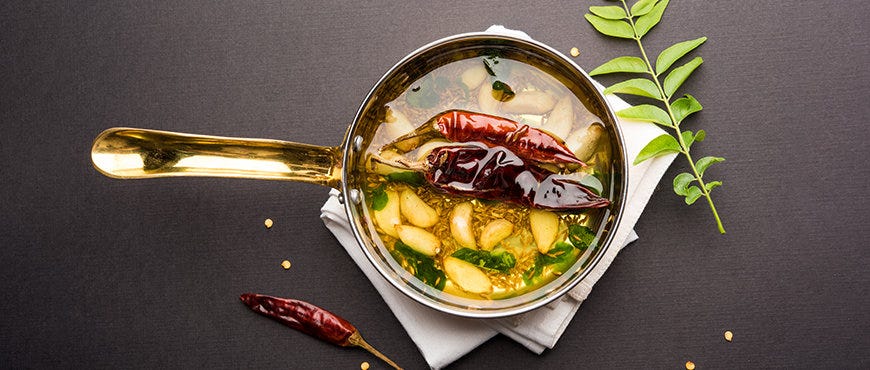It's time to tadka
A rant on why you must always add tadka to your lentils and a recipe for Triple Tadka Dal (because if dal tastes good with one tadka, it tastes divine with three!)
On this page:
When I came back to New Zealand in 2019, one of the things I was happy to see was packets and tins of lentils available in major supermarkets. Wow.
I remember that was not the case when I was a fresh-off-the-boat teenager living in Auckland. Mum would drive 10km to the one Indian shop we had in our neighbourhood to buy dal. The shop owner stored them in big, transparent plastic tubs at the back of his grimy, white tube light lit shop. You could see all the dust particles that had settled around the tub as you scooped your stock of lentils into the thin plastic bags.
Mum’s favourites to buy were toor (yellow pigeon pea), black masoor (black lentil) and chana (yellow split pea or Bengal gram). She’d buy enough to keep us going for a month or two so we didn’t need to come back in a hurry.
It was great therefore to see all of those available in the aisles of my local supermarket. Some like red masoor (red lentils) in sealed packets and others like black lentils in cans.
What was not great to see was a colleague in the office opening up a can of black lentils, adding a bit of salt, pepper and butter and pop their bowl into the microwave.
Inside, I was screaming, “No, that is NOT how you eat dal.”
On the outside, I asked her curiously, if she had heard of Ghee. Or Tadka.
Ghee tadka is to India what the mother sauce is to France. And I’m here to tell you that adding Ghee to almost any dish will make it taste divine.
While you can simply use ghee as fat for frying or to replace butter, the place where ghee shines is when you use it for a tadka. Tadka (pronounced turd-kaa) or Tarka is the Hindi name for tempering or blooming spices in ghee. You may also know it as Phodni, Vagaar or Chhaunk.
There’s not much Indians will agree on (except to ask you to make it cheaper), but blooming spices in hot ghee is one of them.
If you’ve gone to an Indian takeaway and tried to be a little adventurous, you might have eaten Tarka Dal. That’s because adding a tadka is one of the best ways to jazz up boring old lentils (yes, even if you’re having it as a salad).
But really, in Indian food, tadka is everywhere.
Practically every Indian dish begins or ends with tadka.

The science of a good Tadka
Indian food writer Krish Ashok explains in his book Masala Lab that the opening “tadka” gives a depth of flavour while the goal of the finishing one is to impart a whiff of flavour.
Opening tadka’s will often have onions, ginger, garlic and whole spices like cinnamon or star anise. Finishing tadka’s in comparison will focus on aroma and have cumin, fennel, curry leaves and so on. Krish Ashok breaks down the science to share that what you put in each tadka and when is determined by the thickness of the spice’s coating or the amount of moisture it contains.
Mustard seeds, cumin and pepper are relatively burn-proof, so are added first, while fresh spices like garlic, ginger or curry leaves that burn quickly go towards the end.
For me, understanding this science was a game-changer. It explained why if I tried to add more than 3-4 things to my tadka at once, the ingredients I added first would char and simply taste burnt.
This is where my friend Shanti Petiwala comes in. I remember scrolling through her Instagram and coming across something she called ‘Triple Tadka Dal’. I’ve never gone back to eating Dal the old way again.
What is Triple Tadka Dal
Quite simply, it’s when you add tempered spices to your dal not once, but three times.
Each time, a different combination of ingredients and spices.
Each time, more ghee.
The idea is that the dal gets richer and creamier as more ghee goes in. And, your spices don’t burn and lose their aroma while the other ingredients stay raw.
You can make this dal with any combination of yellow lentils. My favourite is to use a mix of the carb-heavy toor or arhar dal with the nutritious red masoor (red lentil) and a touch of chana dal for added creaminess and protein.
The only downside is that you do need to cook at least 200gm of dal - which would typically serve four - to do all the tadka’s. On the plus side, it can always be frozen!
Keep reading with a 7-day free trial
Subscribe to Beyond Butter Chicken to keep reading this post and get 7 days of free access to the full post archives.




